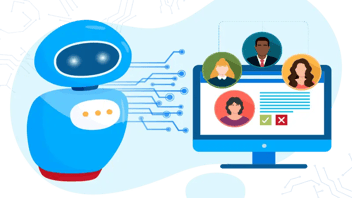Employer Branding as Growth Engine? Why it Works!
When was the last time you checked a company's reviews before buying from them? Probably not long ago.
The truth is, your employer brand doesn't just attract job candidates: it shapes how customers, partners, and investors perceive your business.
In a transparent, people-first economy, the distinction between external brand perception and internal culture has become increasingly blurred. A strong employer brand can become one of your company's most powerful growth engines - improving talent acquisition, employee engagement, and even customer trust. 
Why Employer Branding Matters More Than Ever
Employer branding used to be a topic primarily within the realm of Human Resources. Today, it also overlaps with marketing and growth. In fact, the line between the two seems to become increasingly blurry as time passes.
According to LinkedIn, 75% of job seekers consider an employer's brand before applying, and 92% of consumers trust recommendations from people over ads.
When your employees share authentic experiences online, they don't just attract future hires; they amplify your reputation, credibility, and reach.
The modern audience values transparency and authenticity above all else. If your employees speak positively about your company, customers are more likely to believe in your products or services. That's why companies like HubSpot, Patagonia, and Salesforce invest heavily in internal culture and employee storytelling - not just in ad spend.
The Overlooked Connection Between Employer Brand and Business Growth
Here's the hidden truth: your employer brand isn't just about the recruitment. It directly impacts your bottom line.
Think of it as the brand halo effect. When people perceive your company as a great place to work, they assume your products and services are equally great.
Your employees' satisfaction spills over into how they treat customers, how they innovate, and how they communicate your mission.
Research by Gallup shows that companies with highly engaged employees outperform their peers by 21% in profitability. The message is clear: when your people are thriving, your brand grows faster.
So, what makes employer branding a true growth engine?
-
It reduces hiring costs and turnover.
-
It increases productivity through stronger engagement.
-
It builds trust with customers and partners.
-
It boosts retention for both employees and clients.
It's not just a nice-to-have. It's a growth multiplier.
Building the Foundation: Culture, Purpose, and Consistency
Before you can market your employer brand externally, you need to live it internally.
A strong employer brand starts with a clear sense of purpose, a consistent culture, and visible leadership. If what you say on LinkedIn doesn't match what employees experience in real life, your credibility disappears instantly.
Aligning What You Say and What You Do
Branding is consistency
Your visuals, tone, and messaging—whether in recruitment ads, customer emails, internal memos, or Glassdoor responses—should feel like they belong to the same company. This isn't just about using the right logo; it's about adhering to a single, unified brand voice that reflects your core values in every interaction. When there is a mismatch, candidates and customers alike sense the inauthenticity, and trust immediately erodes.
The Power of the Consistent EVP
The foundation of this alignment is your Employee Value Proposition (EVP)—the unique set of benefits employees receive in return for the skills, capabilities, and experience they bring to the company. Your EVP must be the north star for all internal and external communication:
-
-
External Consistency: Your career page, job descriptions, recruitment social media posts, and even your employee referral program language must clearly articulate and promise your EVP.
-
Internal Consistency: This promise must be delivered and lived out daily in your company culture, performance reviews, development programs, and compensation.
-
For example, if your external messaging promotes "radical flexibility," but your internal policy requires employees to seek management approval for every hour they work remotely, the brand promise has been broken.
Establishing the Single Brand Voice
To ensure consistency across the organization, you must treat your employer brand voice with the same rigor as your customer brand voice:
-
-
Define Shared Tone Keywords: Identify 3-5 keywords (e.g., Bold, Supportive, Transparent, Innovative) that describe your company. All teams—HR, Marketing, and Leadership—must use these to guide their content.
-
Create Cross-Functional Review: Implement a light review process where a member of the Marketing team proofs key HR communications (like a new careers page), and a member of HR reviews customer-facing content for any cultural disconnects.
-
Ensure Visual Harmony: The photography used in recruiting materials should match the style and feel of your customer-facing marketing. If your customer brand is clean and modern, your employment brand shouldn't look stiff or dated.
-
A Quick Self-Check
Ask yourself:
-
Do our internal values match our external messaging?
-
Are our leaders visible and authentic online?
-
Are we telling real employee stories, or generic corporate slogans?
When the answers are yes, you’re not just marketing a brand - you’re building trust.
The Culture Equation
Culture drives behavior, and behavior defines your brand.
Invest in employee wellbeing, flexible work, and professional development. These experiences become the stories your people share publicly—and those stories shape perception more effectively than any paid campaign.
I've seen it happen in growing companies: culture becomes the ultimate marketing asset.
From Employees to Ambassadors: Turning Culture into Content
Your best brand ambassadors already work for you.
People trust people more than logos. A LinkedIn study found that content shared by employees gets twice the engagement of content shared by companies.
How to Activate Employee Advocacy
-
-
Start small. Encourage your most engaged team members to share authentic content about their daily work, milestones, or company initiatives.
-
Provide structure. Offer guidelines or post templates, but never scripts. Authenticity beats perfection.
-
Recognize and reward. Highlight top advocates in internal newsletters or team meetings.
-
Make It Easy and Natural
Create a shared content folder with posts, visuals, and talking points. Encourage different formats, from short reflections to quick videos.
Show that advocacy isn't about bragging; it's about pride and connection.
Your employees are the voice of your brand. When they speak from experience, people listen.
By empowering employees to own their voice, you humanize your company - and that's what modern branding is all about.
The Ripple Effect: How Employer Branding Boosts Everything Else
Employer branding isn't an isolated effort. It touches every part of the business.
-
-
Marketing: authentic employee stories enhance brand storytelling.
-
Sales: customers trust brands with visible, happy teams.
-
Recruitment: reduces time to hire and improves candidate quality.
-
Retention: employees feel valued and aligned with the mission.
-
Each of these ripple effects fuels long-term growth. The stronger your internal culture, the easier it is to attract talent, convert customers, and retain both.
Measuring the ROI of Employer Branding
You can't improve what you don't measure.
Tracking employer brand performance isn't just about vanity metrics - it's about proving its business impact.
Here are the KPIs to monitor:
|
Category |
Metric |
Why It Matters |
|
Recruitment |
Time to hire, cost per hire |
Lower numbers mean your brand attracts talent faster. |
|
Engagement |
Employee advocacy participation rate |
Reflects internal enthusiasm and cultural strength. |
|
Retention |
Turnover rate, internal promotion rate |
Indicates satisfaction and long-term alignment. |
|
Marketing Impact |
Organic reach of employee content |
Measures how far your internal voice travels externally. |
|
Reputation |
Glassdoor rating, NPS, customer reviews |
Tracks overall brand trust from inside and outside. |
Employer branding has compounding returns - small improvements today pay off exponentially over time.
How to Get Started (Even on a Small Budget)
You don't need a huge budget or a PR agency to start strengthening your employer brand.
Here's how to begin right now:
-
Audit your presence. Check what your careers page, social channels, and reviews say about you.
-
Ask your people. Conduct quick surveys or interviews about how employees describe your culture.
-
Tell real stories. Use authentic photos, behind-the-scenes content, and quotes from your team.
-
Align HR and Marketing. Build a shared content calendar that includes both hiring and brand campaigns.
-
Train your team. Offer mini-sessions on personal branding and content creation.
Consistency beats complexity. Focus on steady, honest communication over flashy campaigns.
Real-World Examples: Employer Branding Done Right
HubSpot - Culture Code
Their "Culture Code" presentation went viral because it was transparent, honest, and relatable. This was a detailed and transparent presentation that publicly defined HubSpot's core values, mission, and the company's commitment to treating its employees fairly. It was notable for its radical honesty about what the company stood for and what it expected, becoming a definitive guide for modern, people-first company culture. It's now one of the most referenced documents in modern HR and marketing circles.
Salesforce - #TeamEArth
Their #TeamEarth initiative connects employee purpose with brand purpose - showing how a company's values can inspire both staff and customers. This was a corporate social responsibility and employee advocacy program that connected the company's commitment to environmental and climate action with its employees' personal values. It encouraged staff to champion sustainability, effectively linking Salesforce's brand purpose with a global cause that inspires both employees and customers.
Canva - Natural Brand Ambassadors
The design giant encourages every employee to post freely about their projects, events, and team milestones. Canva's strategy is not a single campaign but an ongoing cultural approach focused on empowering every employee to be a natural brand ambassador. By prioritizing trust over control, they encourage staff to share authentic, unscripted content about their work life, which results in a massive, credible, and engaging wave of organic social media posts. The result? A wave of organic advocacy that feels real, not rehearsed.
Each of these brands proves the same point: Employer branding is not a campaign—it’s a culture.
Common Mistakes to Avoid
-
Treating employer branding as a recruitment ad. It's about storytelling, not job listings.
-
Being inconsistent. Don't show one version of your company externally and another internally.
-
Over-controlling the message. Let employees express themselves in their own tone - authenticity matters more than polish.
-
Ignoring feedback. Glassdoor reviews, exit interviews, and internal surveys offer valuable insight.
-
Neglecting leadership visibility. If leaders never speak publicly, the brand feels faceless.
The Future of Branding Is Human
AI and automation are reshaping marketing, but human connection remains the ultimate differentiator. Customers want to know who's behind the brand, what those people stand for, and how they're treated. Tomorrow's most successful companies won't just sell great products - they'll attract great people who build great experiences.
Employer branding sits at that intersection of culture, marketing, and growth. It's the stories your employees tell when you're not in the room - and it's the story the world believes.
It's key to remember that your people are the brand
When employees feel proud, they take pride in sharing it.
When they share their pride, they build your reputation.
And when reputation grows, so does your business.
Treat your employer brand not as an HR function but as a marketing powerhouse. Because at the end of the day, your most powerful campaign isn't the one you publish - it's the one your people live every single day. At Aspiration Marketing, we can do both: share your stories and help you grow your business.
This content is also available in:
- German: Employer Branding als Wachstumsmotor? Warum es funktioniert!
- Spanish: La marca del empleador como motor de crecimiento Por qué funciona
- French: L'importance de l'image de marque employeur pour la croissance
- Italian: L'Employer Branding come motore di crescita? Perché funziona!
- Romanian: Brandingul angajatorului ca motor de creștere? De ce funcționează!
- Chinese: 雇主品牌是增长引擎?为何有效?

Opinions expressed in this article are those of the guest author. Aspiration Marketing neither confirms nor disputes any of the conclusions presented.








Leave a Comment